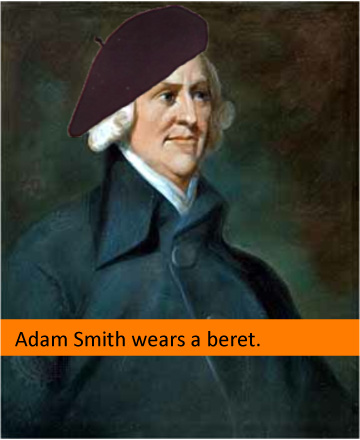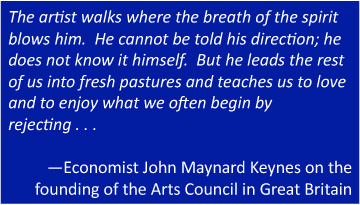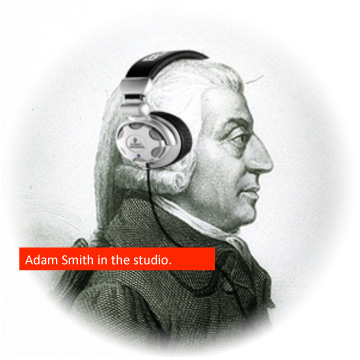Part 2 of what art and economics have to do with each other. . . .
A few years ago I came across a biographical sketch of Adam Smith, founding architect of economics, in a book by Walter Bagehot, the British essayist, businessman, and former Editor-in-Chief of The Economist magazine. (The Economist‘s “Bagehot” column on British life, politics, and current affairs is named for him.)
I found the essay, “Adam Smith as a Person,” in a general book called Biographical Studies (London: Longmans, Green, and Co., 4th Ed, 1899). That book sat on a high, dusty shelf in a section of the London Library called “Miscellany.” A cursory review of Adam Smith bibliographies did not turn it up, though, following from Murphy’s Law, I’ll brace myself for angry scholarly corrections.
Was Adam Smith an artist?
He was a philosopher who founded the field of economics. I think that act of invention, along with the way he did it, makes him an artist. His thinking was as original and—to borrow a business-ism, “game-changing”—as the first Cubist painting.
1. temperament
The godfather of modern capitalism—whose 1776 book The Wealth of Nations laid the framework for the field of economics—was described in Bagehot’s essay as “one of the most unbusinesslike of mankind.”
Bagehot wrote, “He was an awkward Scottish professor, apparently choked with books and absorbed in abstractions. He never engaged in any sort of trade, and would probably never have made sixpence by any if he had been. His absence of mind was amazing.”
Bagehot went on to recount a time a stallworker at the Edinburgh fish market once described Smith as seemingly crazy though surprisingly well dressed—“taking him for an idiot broken loose.” On another occasion, Smith was asked to sign a document and instead of writing his own name, produced “an elaborate imitation” of the signature on the line above his.
Smith was, however, a keen observer of actual economic behavior. For instance, he became disillusioned during a Snell fellowship at Oxford that, he felt, the smartest men had gone into the Church of England over academia because the pay was better. An economic actor himself, he also took two years out of professorly duties to travel around France as the well-paid tutor of a twelve-year-old boy. (Some modern-day artists have this commercial instinct in spades.)
2. imagination
Smith made his debut into academic society in 1759 with A Theory of Moral Sentiment, essentially an ode to the imagination by way of the concept of sympathy. He believed that sympathy – “fellow feeling for mankind” –was the glue in society. We understand and care for each other by imagining our way into each others’ shoes. In that way, the essentially artistic quality of imagination becomes much more basic to the social fabric than, say, the inexorable intersection of supply and demand.
3. creative process
The Wealth of Nations was, in many ways, the accidental and specific result of an almost quixotic research project. The book we know was a by-product of a utopian project to write a holistic theory of everything. As Walter Bagehot wrote:
[The Wealth of Nations was] in the mind of its author only one of many books, or rather a single part of a great book, which he intended to write. . . . He wanted to trace not only the progress of the race, but also of the individual; he wanted to show how each man being born (as he thought) with few faculties, came to attain to many and great faculties. He wanted to answer the question, how did man—race or individual—come to be what he is?
Smith researched this project against the backdrop of mercantilism, the prevailing economic belief that hoarding was good. You wanted to keep the output of your own economy within your borders. Smith argued for trade, for the “self-regulating” nature of enlightened self-interest. His theory came from his observations of the time in which he lived. But it wasn’t what he set out to do. His story joins the canon of concerted but accidental progress, tales ranging from Alexander Fleming’s unlikely discovery of penicillin to the proverbial “who put their chocolate in my peanut butter” case for Reese’s cups.
4. defining art
Among the basic tenets of Smith’s system is the assumption of the free availability of “perfect information.” He believed that you could be at point A and see, know, value, price, and trade in relation to point B. That’s somewhat ironic given that his own process of discovering these ideas was of being at point A and inventing point B.
Consider this definition of art, that applies to Adam Smith’s work: The philosopher Martin Heidegger said—and I am borrowing and adapting from an essay “On the Origin of the Work of Art”:
A work of art is something new in the world that changes the world to allow itself to exist.
Think about this view of art: You create a thing in the world that changes the world to allow itself to exist. By that definition, Google or Facebook, or the Internet itself is art too.
Adam Smith created the field of modern economics through observation of prevailing customs, whether trade among nations or the design of work in pin factories. The result is one of the great organizing constructs of our lives–for everyone, artists included.
5. guiding questions
In Adam Smith’s case, there he was at point A as a philosopher, tracking opulence and progress. Then all the sudden his point B rippled out, becoming the metaphor of an invisible hand that tracks, predicts, and makes possible the whole market economy. He had one question in mind and then allowed the answer to change the question. To Heidegger’s point, the theory Smith put together certainly changed the world.
Bagehot once wrote: “It is often said that men are ruled by their imaginations; but it would be truer to say they are governed by the weakness of their imaginations.”
This seems true in every field. The weakness of the imagination could be the personal, temperamental difficulty of dealing with ambiguity and uncertainty. It could be the difficulty of persevering and recognizing opportunity in the circuitous, accident-ridden process of discovery. What if Adam Smith had only published his work if it had reflected his exact starting intention–to track the history of opulence and the progress of man?
One critical moment in any artistic process is when your own guiding question leads to to veer off course from what you thought, at the outset, you would make. You look at the new work and think: “Is this brilliant or awful? I can’t tell.” You just carry on. You just keep trying to clear the hurdles as they appear on the 100-yard dash that is making a art. As Smith’s earlier work–The Theory of Moral Sentiment–proved, imagination is the biggest hurdle of them all.
Adam Smith: artist, economist, hurdler.
As a separate topic for a later blog post, what does it mean that artists are economists too?







Pingback: The Space Outside Your Head: Some Concluding Thoughts | Art21 Blog
Pingback: Weekend Links: The Critic’s Progress | Stephanie Vegh